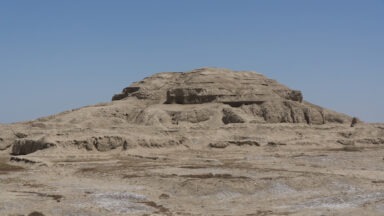Why Has This 1600 Year Old Pillar in India Never Rusted?

The forging of the Iron Pillar of Delhi 1600 years ago in India was so advanced that it has been impervious to rust and would be hard to mimic even with today’s technology.
Architecture and engineering have been dynamic and evolutionary processes, building on innovations in carpentry, stonework and metalwork for millennia. These processes have been well-documented allowing for the ability to glean useful information and develop better contemporary iterations. But one small, mysterious gap in this history raises some questions – a lone-standing pillar in India.
The Iron Pillar of Delhi
In front of a mosque in an area of Delhi, known as the Qutub complex, stands a wrought iron pillar surrounded by a small white fence. The iron pillar of Delhi, though unassuming at first glance, is roughly 1,600 years old and shows no signs of weathering. And while it does stand inland in an arid part of India, it has withstood monsoons – about a thousand of them.
The pillar is thought to have been built during the reign of Chandragupta II, and is 24 feet tall weighing roughly 13,000 pounds. But those numbers are even more astounding when you learn that it was constructed in central India, nearly 500 miles away from its current location, making its method of transport a mystery itself.

For a while the greater perplexity surrounding the pillar concerned its composition and what kept it so preserved. Some of those questions have been answered by examination of the process used in casting it and the thin protective layer enveloping the post known in ancient India as ‘misawite.’ This layer consists of a compound of iron, oxygen and hydrogen and is 1/20 of a millimeter thick. Some believe that this layer was simply an accident, and therefore the reason why it is the only one of its kind that has withstood weathering. But others attribute it to highly-advanced ironsmiths with an unparalleled level of knowledge, and the scientist who has carried out the most well-known examination of the pillar believes it to be intentional.
Today there is a fence around the iron pillar of Delhi to protect it from human touch which in fact has caused it to show some signs of damage. Before the fence was erected, standing with one’s back to the pillar and touching your hands behind it was thought of as lucky or auspicious.
The combination of this sheath and a slightly different method of metallurgy in crafting the pillar, compared to modern methods, is thought to be the reason it has sustained for so long. Typically limestone is used in the extraction of iron, whereas this ancient Indian technique utilized charcoal. Other differing factors include a high level phosphorus in the protective film while also being completely devoid of magnesium and sulfur. But why was this process never continued?
Despite the pillar itself being preserved, the technology used in its creation was not. The anachronistic knowledge used in casting iron during this period could hardly be mimicked today. There’s even evidence that it was hit at close range by a cannonball which merely put a dent in it. But one characteristic of the pillar that gives some insight into its mystery is an inscription written in Sanskrit referencing a royal known as Chandra, who most believe to be a reference to Chandragupta II.
The Gupta Dynasty
The Gupta Dynasty in India was marked by significant advancements and achievements in science, technology, literature and astronomy. They developed the game of chess as well as some of the most famous pieces of literature and drama in Indian history. It was known as India’s Golden Age. Indian scholars during this era understood that the Earth is round and rotates around the sun. They were in tune with cosmic cycles, having awareness of eclipses and other astronomical events
Chandragupta II, also known as Vikramaditya, was one of the most notable rulers of the dynasty who embraced Buddhism and Jainism. This lead to an incorporation of iconography from multiple religions in Indian artwork of that era. He was given the name, and was known for his courage and benevolence. The inscription in the pillar that led to the discovery of its original location turned out to be a place of significant astronomical interest at the time. The pillar itself may have been an astrological tool, like a sundial used to measure the equinoxes.
Ashoka’s Pillars
There are other pillars throughout India that stand alone and are of a similar, massive proportion to the one in Delhi, although they differ in provenance and do show weathering. In fact, some are starting to deteriorate significantly to the point of irreparable damage.
The Ashoka pillars were constructed by Ashoka, a ruler of India whose military conquests proved to become a spiritual and moral dilemma for him. He converted to Buddhism and erected these pillars all over India, but only 19 remain. They were built around 250 BC and were as tall as 50 feet weighing up to 50 tons, significantly larger than the non-corroded iron pillar of Delhi. Ashoka’s pyramids were made of sandstone as opposed to iron. Each pillar was etched with edicts pertaining to Buddhism and were topped with carvings of lotus flowers and different animals. These pillars were also transported hundreds of miles, despite their massive weight and size.

Ashoka used the pillars to reach out to different cultures around the world and declare his apology for his violent military conquests that killed hundreds of thousands. Inscriptions in the pillars are written not only in Sanskrit, but also in Aramaic and Greek. Ashoka placed his pillars along trade routes to maximize the number of people who could see them.
Pillars were clearly an important architectural form of ancient India. And while Ashoka’s pillars stand as the remnants of a rulers remorse and religious repentance, the rust-free iron pillar of Delhi is enshrouded in a protective sheath of misawite and mystery. What happened to the technology that has kept the pillar intact for so long and why aren’t there other pillars like it?
Ancient Sound Technology; The Breath of Creation

Crashing waves. The thump of a palm against a taut drum skin. The wail of a new born baby. Sound is our tether to the present, to one another, and to our deep and ancient sense of the world. Throughout the ages, ancient sound technology, created through voice, instruments, and the natural world has provided healing and spiritual connection.
Every ancient civilization is based on the belief of the sanctity that is sound, from the Old Testament’s verse, “and God said, let there be light,” to the meditative Aum of the Hindu tradition; sound represents a spiritual significance that is essential to the human relationship to nature, self, and one another.
The first ancient people known to use sound as a healing power are the indigenous people of Northern Australia. The ancient culture created a kind of sound healing expressed through the didgeridoo, or its ancient name, the yidaki. Made from fallen eucalyptus branches hollowed out by termites, the didgeridoo is considered to be the oldest wind instrument, dating back more than 40,000 years.
Used in ceremonial rituals and for its healing properties, the didgeridoo was also a way to communicate across far distances due to the unique sound waves which are believed to be able to be heard through the Earth. The low frequencies produced by the didgeridoo are thought to heal, help with mobility, and open up energetic flows.
“He who knows the secret of the sound knows the mystery of the whole universe” – Hazrat Inayat Khan
North American indigenous cultures incorporated “reciprocal participation” in their tribal ceremonies with a complex and interconnected musical exchange that ranged across nations and tribes. Used for ritualistic purposes, creative expression, and healing, making and sharing music has always been central to Native American daily life.
According to the American Indian Heritage Foundation (AIHF), “ [u]nusual, irregular rhythms and a somewhat off-key style of singing are used. No harmony is ever incorporated, although sometimes many people sing at once, and other times the vocals are solo. The Native American vocals are passionate, used to invoke spirits, ask for rain or healing, or are used to heal the sick.”
AIHF states that “many researchers feel that Native American music is some of the most complex ever performed. The tensing and releasing of the vocals combined with varying drum beats make it a very intricate form of art.
In ancient Egypt, seven vowels served as sacred sounds, creating a strong euphony, or harmonic convergence. In addition to the human voice, Egyptian high priestesses played the sistrum in ceremonies, a kind of rattle with metal discs attached to it that generated an “ultrasound” to enhance healing, and which is still in use today. The ancient Egyptians believed so strongly in the power and sanctity of sound that there are no vowels present in their written language of hieroglyphics.




































